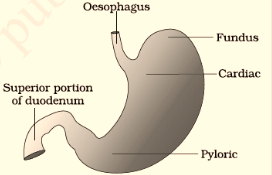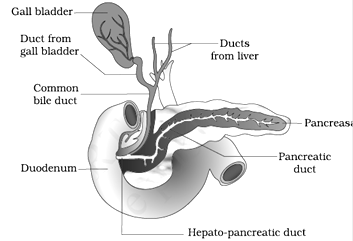Digestion and Absorption - Revision Notes
CBSE Quick Revision Notes
CBSE Class-11 Biology
CHAPTER-16
DIGESTION AND ABSORPTION
The process of conversion of complex food into simpler absorbable form is called digestion and is carried out by digestive system by mechanical and biochemical methods.
Digestive System- Human digestive system consists of alimentary canal and associated glands.

- Alimentary canal begin with anterior opening mouth and opens out posteriorly through anus. It comprises of following parts:-
- Mouth- leads to oral cavity or buccal cavity which contains teeth and tongue.
Upper surface of tongue has small projections called papillae, some of which contain taste buds.
Each teeth is embedded in socket of jaw bone (thecodont). Milk teeth is replaced by permanent or adult teeth, this type of dentition is called diphyodont. Four different types of teeth (Heterodont) are incisors (I), canine (C), premolar (PM) and molar (M).Dental formula: Each half of the upper and lower jaw has following number of teeth- - Pharynx – oral cavity opens into pharynx which acts as common passage for food and air. Cartilaginous flap called epiglottis prevents the entry of food into wind pipe (glottis) during swallowing.
- Stomach- Oesophagus leads to stomach. The opening of stomach is guarded by a sphincter (gastro-oesophageal). Stomach is divided into three parts- cardiac, fundic and pyloric.
- Small intestine- is the longest part of alimentary canal divided into duodenum, jejunum and ileum. Pyloric sphincter is present between stomach and duodenum.
- Large intestine- ileum opens into large intestine, which is divided into caecum, colon and rectum. Caecum is a blind sac which host microbes. Vermiform appendix arises from caecum. Rectum opens through anus.


Histology of Alimentary canal-
The wall of alimentary canal from Oesophagus to rectum consists of four layers.
- Serosa- it is the outermost layer made up of squamous epithelium and areolar connective tissue.
- Muscularis- it is composed of outer longitudinal and inner circular muscle fibres. Muscles fibres are smooth and have network of nerve cells.
- Submucosa- it consists of loose connective tissue richly supplied with blood and lymphatic vessels. Meissner’s plexus is present between the muscular coat and mucosa that controls the secretion of intestinal juice.
- Mucosa- is innermost layer lining the lumen of the alimentary canal. It has irregular folding in stomach called rugae and villi in small intestine. Mucosa forms glands in the stomach (gastric glands) and crypts in between the bases of villi in the intestine (crypts of Lieberkuhn).

Salivary Glands- secrete saliva in oral cavity. In human beings salivary glands are three pairs- parotid, sublingual, and submandibular.
Liver- it is the largest gland in human body lies in upper right side of the abdominal cavity just below the diaphragm. Hepatic lobules, covered by Glisson’s capsule, are structural and functional unit of liver made up of hepatic cells. The secretion is stored and concentrated in gall bladder. Bile duct and pancreatic duct open together in duodenum by common duct guarded by sphincter of Oddi.

Pancreas- It is soft lobulated greyish pink gland which weighs about 60 gm., consists of exocrine and endocrine portion. The exocrine portion secretes alkaline pancreatic juice and endocrine secretes hormones insulin and glucagon.
Digestion of food
Carbohydrates, fats, proteins and nucleic acids occur in food in the form of large and complex insoluble macromolecules (polymers). These macromolecules are converted into small monomers by the action of enzyme.
- In buccal cavity, teeth and tongue help in mastication and mixing of food. Mucus in saliva mix with masticated food to form bolus.
- Bolus is passed to pharynx and Oesophagus by swallowing or deglutition.
- Chemical digestion of food starts in oral cavity by the action of enzyme salivary amylase and lysozyme.
Lysozyme acts as antibacterial agent in mouth to prevent infection.
Salivary amylase breaksdown starch into maltose - Mucosa of stomach have gastric glands having three types of cells- mucus neck cells that secrete mucus, peptic or chief cells that secretes proenzyme pepsinogen and pariental or oxyntic cells that secretes HCl.
- Food mixes with gastric juice due to churning action of muscular wall to form chyme. HCl activates the pepsinogen to pepsin to digest protein into peptones and proteoses
- Mucus and bicarbonates present in gastric juice play important role in lubrication and protecting inner wall of stomach from the action of HCl. Renin is a proteolytic enzyme found in gastric juice of infants to digest milk protein.
- The Bile, pancreatic juice and intestinal juice are released in small intestine. Pancreatic juice contain inactive trypsinogen, chymotrypsinogen, procarboxypeptidases, amylases, lipases and nucleases.
- Trypsinogen is activated by enzyme enterokinase in to trypsin, which further activates the other enzyme of intestinal juice.
- Bile contains bile pigments (bilirubin and bil-verdin), bile salts, cholesterol and phospholipids which help in emulsification of fats.
- Secretion of brush border cells of mucosa and goblet cells contain enzyme succus entericus, containing variety of enzymes to complete the process of digestion.
Function of large intestine
- Absorption of water, minerals and certain drugs.
- Secretion of mucus for adhering of the undigested food and lubricating it for easy passage.
Absorption of Digested Food
Absorption is the process by which nutrients pass from the alimentary canal into the blood and lymph through its mucous membrane.
- Amino acids, monosaccharide, fatty acids, glycerol, salts, vitamins and water are to be absorbed. About 90% of absorption occurs in small intestine and rest 10% in stomach, mouth and large intestine.
- The passage of different absorbent depends upon concentration gradient for some substances like glucose and amino acids and electrolytes.
Absorption in different part of alimentary canal-
Mouth | Certain drugs coming in contact with the mucosa of mouth and lower side of tongue are absorbed into the blood capillaries lining them. |
Stomach | Absorption of water, simple sugar and alcohol takes place. |
Small intestine | Glucose, fructose, fatty acids, glycerol and amino acids are absorbed through the mucosa into the blood stream and lymph. |
Large intestine | Absorption of water, some minerals and drug takes place. |
Disorder of Digestive System
The inflammation of intestinal tract due to bacterial infection, fungal infection and parasitic infection caused by tapeworm, round worm, threadworm and pin worms.
- Jaundice- it is a disease of liver. In jaundice the skin and the eyes turn yellow due to large quantities of bilirubin pigments in the extra cellular fluid.
- Vomiting – it is the ejection of stomach content through the mouth. This reflex action is controlled by the vomit Centre in the medulla.
- Diarrhoea- frequent defection of liquid faeces is known as Diarrhoea. It reduces the absorption of food.
- Constipation- in constipation the faeces are retained within the rectum as the bowel movements occur irregularly.
- Indigestion- incomplete digestion usually accompanied by one or more of the following symptoms- pain, nausea, vomiting, heartburn, acid regurgitation, accumulation of gas and escape of gas from the stomach.